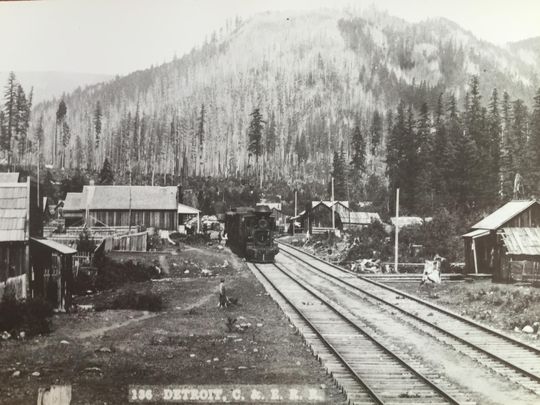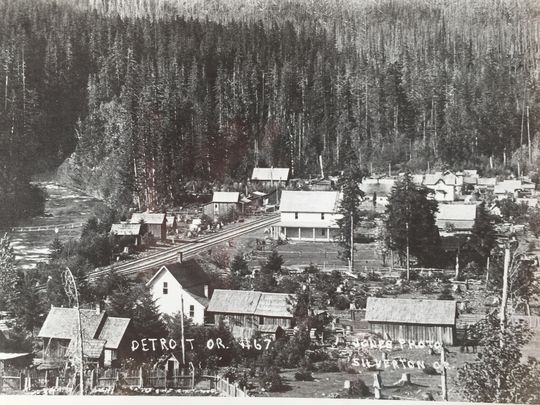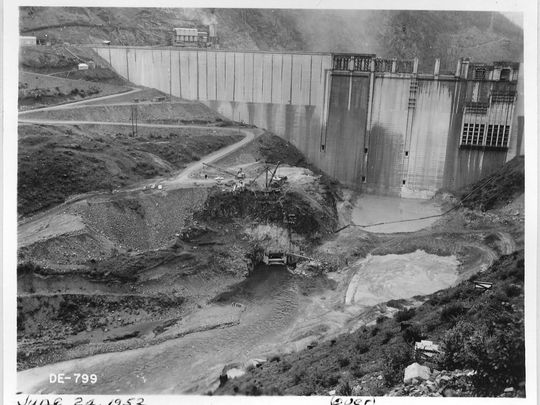First published in December of 2015
SALEM, Ore. — Heavy rainfall is washing away memories of the summer’s drought but not a surprising historical discovery made at Detroit Lake when it was at its lowest level in 46 years.
Marion County Sheriff’s Deputy Dave Zahn is one of a few people this fall who spotted a 19th-century utility wagon lying lakeside in the mud when the reservoir drained to 143 feet below capacity. He’d expected to see remnants of Old Detroit — the 200-person town abandoned and flooded when the dam was finished in 1953 — but nothing like what he actually found.
"I went on a treatsure hunt along the river, figuring I’d find foundations or something like that,” Zahn said. “Then I saw a piece of old history right there.”
With the wagon, he also found a cement-lined octagonal pit that no one’s been able to identify.
On that day, Oct. 29, Zahn perched on a stump to get out of the deep, sucking mud, marveling and snapping pictures. But he waited to share what he’d found with friends and co-workers until rainstorms raised the water level and submerged the wagon again. Now the lake is 80 feet deeper and has reclaimed this piece of its history.

“I was worried about vandalism or people coming out to try and take a part of it,” Zahn said.
So were staff members at the Detroit Ranger District headquarters nearby. U.S. Forest Service archaeologist Cara Kelly asked that the wagon’s exact location be kept secret to protect it from vandals.
“I don’t think people realize they aren’t supposed to collect items off public land,” she said. “But once someone removes something, nobody else will get to see that piece of history.”
Preserved beneath the reservoir’s waves in a low-oxygen environment, the wagon was probably more damaged during its short public appearance than it was underwater for decades, she said.
Now that the wagon is hidden again, Kelly is puzzling over where it came from. A cast iron plate on its tongue says its maker was the Milburn Wagon Company of Toledo, Ohio, which was the world’s largest wagon-maker in 1875. A historical organization in Ohio pegged a similar wagon’s age at 130 years old.
She wonders whether it was used in the construction of the railroad in the late 1800s and then left behind when the original Detroit town site was abandoned in 1952 to make way for the 3,580-acre reservoir.
“I’m thinking somebody just walked away from it,” added Frances Thomas, president of the North Santiam Historical Society.

Old Detroit existed from 1880 to 1952. It was born as a railroad construction camp for the multi-ethnic workers who built the Oregon Pacific Railroad deep into the state’s forestland. From Salem, the track ran up the canyon, right along the roaring North Santiam River, to the flanks of the Cascade Mountains.
Businessmen had visions of building the railroad over the pass to Central Oregon and beyond to join the Transcontinental Railroad. But it never reached beyond Idanha. Detroit’s railroad turntable, sitting in the shadow of a mountain known today as Piety Island, was basically the end of the line.
Loggers living in Detroit and smaller camps sprinkled throughout the Cascades sent millions of board feet of lumber down the line to the valley. In town, one could find a school, hardware store, cafes, taverns, a church and even a movie theater.
It was the Flood Control Act of 1938 that put Detroit Dam on Congress’ to-do list. Floods were an unwelcome reality for the farmers who lived down the canyon and along the Willamette River downstream.
“For farmers and boosters in the Willamette Valley, the North Santiam made life hell,” wrote Bob Reinhardt, local historian, professor and president of the Western Heritage Center. “Gathering snowmelt and rainfall in the Cascades, the river contributed to floods that washed through Salem and other valley towns, sometimes causing millions of dollars in damage.”
Detroit Dam and its companion, Big Cliff Dam, became part of a regional plan for the Willamette Basin to reduce flooding and generate electricity. At 1,580 feet long and 360 feet high, it was designed to hold 455,000 acre-feet of water.
If Detroit residents were upset by the prospect of losing their town, the record only shows that they went as far as to petition the government for a tract of land on which to re-site the city. Rebuffed, they approached timber baron A.B. Hammond, who willingly developed one of his old logging camps nearby into a new town site. By June of 1952 — the government’s deadline for abandoning Old Detroit — Hammond had sold 67 lots for a total of $42,800, Reinhardt wrote. Some residents actually moved their homes to the new site. The new town’s iconic Cedars Restaurant and Lounge is one of the buildings moved to higher ground on sleds.
“Residents of Old Detroit bought 45 of those lots; the rest went to recent arrivals looking for their own lakeside retreat or hoping to cash in on the expected tourism boom,” he wrote.
When the dam went operational, the North Santiam River transformed from a river rushing by Old Detroit into the 9-mile lake that drowned it. The railroad and old highway disappeared into the water too.

But, every winter, when the dam spillways are opened and the lake drops to make room for spring runoff, remnants of the old town are visible to those willing to make the muddy trek to see it.
Across the lake, another “town” makes a regular appearance when the lake is low. At the Mongold Day Use Area, winter visitors can sometimes see foundations belonging to the government camp built in 1949 to house dam workers. According to a 1979 article in Oregon Territory, it included 12 single apartment units, a mess hall, a fire department building, 48 trailer houses and recreation building.
“People get confused about this,” Thomas said. “They think that Mongold is where Old Detroit was.”
Like Old Detroit, Camp Mongold usually hides beneath the waves as visitors swim, fish and boat from the park all summer.
But this year, Detroit Lake started the season 60 feet short of full pool, according to Corps’ data. From its high point on May 4, it drained away quickly, exposing the camp’s foundations to beachgoers by midsummer and eventually falling to a record low of 1,426 feet.

Only once in its 62-year history, has the lake gotten that low, in January of 1969. On three other occasions — 1972, 1989 and 1997 — it drained down to 1,427 feet, according to the Corps.
“As far as I know, the wagon’s never been seen until this year,” Kelly said. Either the lake water never fell below it, no one noticed or mentioned it, or it migrated with the currents from somewhere else.
“This might not have been its original resting place,” she said. “It could’ve come from anywhere in the town of Detroit or even up the drainage. The flood of 1964 moved a lot of things; it even brought houses down. The lake was just covered with logs and debris back then.”
When Detroit Lake’s year-round winter boat dock closed on Oct. 1, Deputy Zahn realized this was his once-in-career chance to see the exposed landscape. As a marine deputy, he’s patrolled Detroit Lake for 12 years and heard many stories about the area’s history.
While it was a thrill to catch a glimpse of the past, Zahn said he doesn’t want to see another dry year like this one for a long time.
“Hopefully it will be another 40 years before Detroit’s this low again,” he said.

